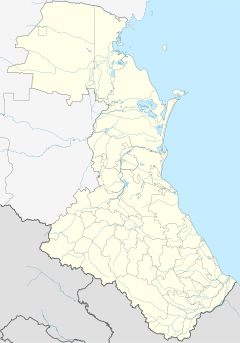Kumukh
|
Kumukh Gumuk (Lak) |
|
|---|---|
| Village | |
| Coordinates: 42°10′14″N 47°07′03″E / 42.17056°N 47.11750°ECoordinates: 42°10′14″N 47°07′03″E / 42.17056°N 47.11750°E | |
| Country |
|
| District | Laksky District |
| Population | |
| • Total | 2,483 |
| Time zone | MSK (UTC+3) |
| • Summer (DST) | MSD (UTC+4) |
| Area code(s) | +7 87267 |
| Website | http://www.gazikumuh.ru/ |
Kumukh (Lak: Gumuk) is a village and the administrative center of Laksky District in Dagestan. It is located on the banks of the Kazikumukh Koysu, a branch of the Sulak River.
To name Kumukh Laks use the name "Lak" or "Lakral kanu" (the Lak place). The naming of the surrounding villages as "Lakral sharhurdu" meant that they belong to Lak. In all probability, in ancient times Laks lived in the small village of Lak. The toponym "Lak" was adopted only in the Lak language. In the understanding of Laks, Kumukh was a fortress of Lak city and then in the general sense became the capital of the Lak principality.
Historical literature mentioned Kumukh in a variety of pronunciations. Al-Masudi in the 10th century mentioned "Gumik" as a city or a principality. Al-Kufi in the 10th century mentioned fortress "'Amik" which is taken as "Gumik ". Ibn Rust in the 10th century named Kumukh as a fortress "Alal and Gumik". Prefix "Alal" can be taken as "al-Lak" that was the name of the inhabitants of Kumukh or its territory.
In the 14th century Kumukh was named "Gazi-Gumuk" (in Lak). The prefix "Gazi" meant that Kumukh was the military and political center of Muslims. In the 14th century Turkic historians (Shami, Yezdi) mentioned Kumukh as "Gazi-Kumuk" (the possession of shamkhal). In the 15th–16th centuries the inhabitants of northern Dagestan named Kumukh as "Kazi-Kumuk" (in Turkic) and "Kazi-Kumukh" (in Russian). In the chronicle Derbent-Nameh (17th century) Kumukh of 6th century and the 8th century was named "Kumuk". In the 19th century Russians capturing Kumukh named it "Kazi-Kumyk" and its inhabitants "Lak" that for Laks also meant toponym.
Kumukh is the historical center of the Lak people and existed before they converted to Islam. The first reliable information about Kumukh dates to the 6th century when Kumukh was part of Sassanid Empire. In 734 Kumukh became part of the Arab caliphate. General and historian Vasily Potto wrote: "The Arabs have put someone named Shah-Bal the ruler of the Laks". In 778 the construction of the first mosque was completed in Kumukh and Islam got established in Lakia. Gazi-Kumukh had been in the past a large trading and political center of Dagestan, the capital of Gazikumukh Shamkhalate and later of Gazikumukh Khanate.
...
Wikipedia

